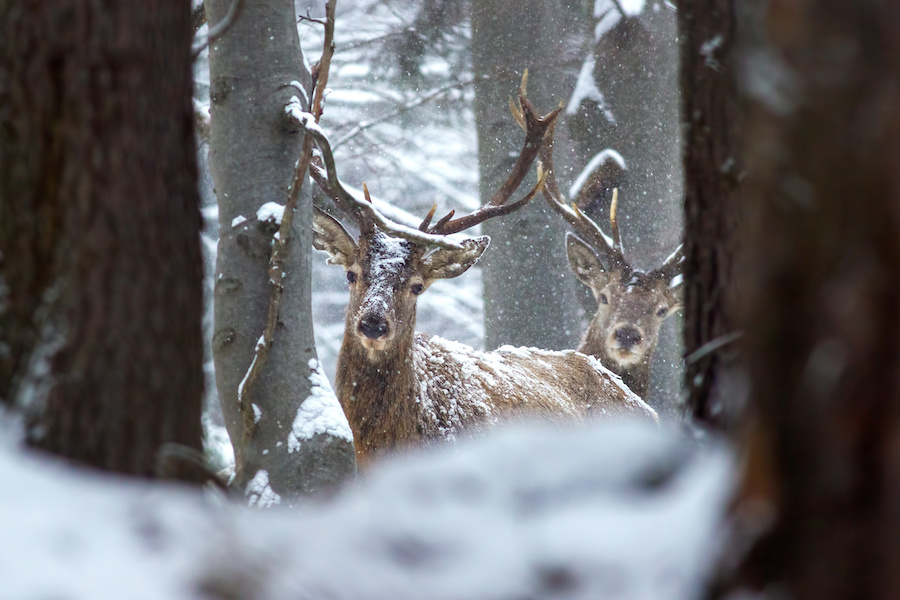During this time of year, when snow and freezing temperatures cover the ground and the air, many of us enjoy gazing out our windows at the picturesque sight of a peaceful, white landscape. On the other hand, this time of year presents a risky obstacle for the herds of white-tailed deer.
Whitetail deer, well-known for their toughness and versatility, face the difficult challenge of surviving the harsh winter weather. This post will discuss the various obstacles these animals may encounter throughout the winter months, the severe weather’s impact on their survival, and the conservation measures to protect this well-known species.
The Struggle of the Whitetail Deer During the Winter
White-tailed deer can be found in a wide variety of habitats across North America, including grasslands, woods, and even urban areas. These animals, easily identifiable by their distinctive white tails and acute senses, have successfully adapted to various settings. The onset of winter, however, puts their adaptability to the test in multiple ways.
- The Effects of Cold
Whitetail deer are not designed to survive in extremely cold environments. They have very little body fat, which, combined with their thin fur, makes them susceptible to hypothermia and frostbite. Plunging temperatures and biting winds can be extremely hazardous during particular severe winters.
- A Decrease in the Amount of Food
Another big obstacle that winter provides is a decrease in the available food because of the cold weather, plant growth is stunted, which makes it challenging for deer to find enough food to consume. Their diet changes to consist of woody browse, such as twigs and branches, which are more challenging to digest and provide a lower quality of nutrition.
- Extremely Deep Snow
Intense snow can hinder the movement of deer, making it difficult for them to obtain food sources or escape from predators. In addition, because deer have to use more energy to make their way through the heavy snow, this might cause them to become exhausted, further decreasing their chances of surviving.
The Effects Winter Weather Can Have
Even while whitetail deer have developed to withstand some harsher winter conditions, the intensity of certain weather events can change the balance against them. In recent years, several cold snaps and high snowfall have had disastrous implications for deer populations.
- Winter Kill Events
“Winter kill” events occur in years with unusually harsh winters. Because of these events, the mortality rate among deer has significantly increased due to the effects of cold stress, malnutrition, and disease. It is easier for conditions such as chronic wasting disease (CWD) to infect deer weakened for an extended period by prolonged exposure to cold and an inadequate food supply.
- Decline in Population
Harsh winter circumstances can bring about a decline in the deer population, which can have negative effects on ecosystems. It is possible for predators like wolves and cougars, which rely on deer as their primary source of food, to experience food shortages as well, which could affect their numbers.
Efforts Made Regarding Conservation
Wildlife agencies and organizations have adopted various conservation activities to recognize the importance of white-tailed deer in the region’s ecosystems. These initiatives are designed to assist white-tailed deer in overcoming the challenges posed by winter and thriving over the long term.
- Habitat Management
It is necessary to manage the habitats of deer. When natural fodder is scarce, providing deer with extra food sources in the form of winter feeding plots can assist the deer in finding nourishment. The establishment of vegetation that is suitable for deer can also be encouraged through the use of controlled burns and selective logging.
- Winter Shelters
During the winter months, several organizations supply deer with winter shelters, which can help shield them from the adverse effects of the weather. It is common practice to position these shelters in such a way as to minimize the effort that deer must put to find safety.
- Population Control
Keeping a healthy balance in the number of deer in an area is essential to prevent overgrazing and habitat deteriotion. Whitetail deer hunting Texas seasons that are tightly regulated are an efficient strategy for controlling the number of deer in an area while simultaneously offering chances for hunters.
- Disease Management
For the long-term health of deer populations, effective disease management, including managing chronic wasting illness, is crucial. Monitoring and research efforts are ongoing to understand these disorders better and develop more effective treatments.
We must remember, as we look out our windows and admire the winter paradise that has been created, the difficulties that the white-tailed deer population is experiencing during this time of year. Extreme weather can result in severe losses among deer populations, negatively influencing ecosystems and biodiversity.
However, thanks to the commitment of wildlife authorities, organizations, and conservationists, initiatives are underway to address these difficulties and ensure that this iconic species will continue to exist in the wild. We may contribute to preserving our natural heritage and conserving white-tailed deer by supporting these projects and pushing for the appropriate management of animal populations.

